Today, Nick and I paid to tour the ruins of Ephesus, which lie just a few kilometers outside of Selçuk. (And which are, quite frankly, the only reason people come to Selçuk.) For the most part, I found the trip tedious. But I had a good day.
Ephesus was a major city in the ancient world, once boasting a quarter of a million inhabitants. The Temple of Artemis — one of the Seven Wonders of the Ancient World — was located here. The apostle Paul lived here as he helped to spread the early Christian church. (He wrote the first letter to the Corinthians here, as well as the epistle to the Ephesians.) Another apostle, John, lived and worked in Ephesus. In fact, he died here. What’s more, he’s purported to have brought Jesus’ mother Mary to Ephesus. (This morning, we visited the supposed house where Mary lived. So did thousands of other tourists.)
With all this history, why didn’t I care for Ephesus? Because frankly, I’ve seen enough Roman ruins in my lifetime. Can you believe I’ve become this jaded? I have. There was nothing in Ephesus I hadn’t seen before, and the place was crowded. Damn crowded. Our tour guide estimated that 30,000 people passed through the gates today. I think he may have under-estimated.
If you’ve never seen Roman ruins, or if you have a particular interest in Christian history, then Ephesus might be a keen place to visit. But if you have seen Roman ruins (in Rome, for instance) or aren’t particularly interested in Christian history, I wouldn’t recommend Ephesus as a “must-see”.
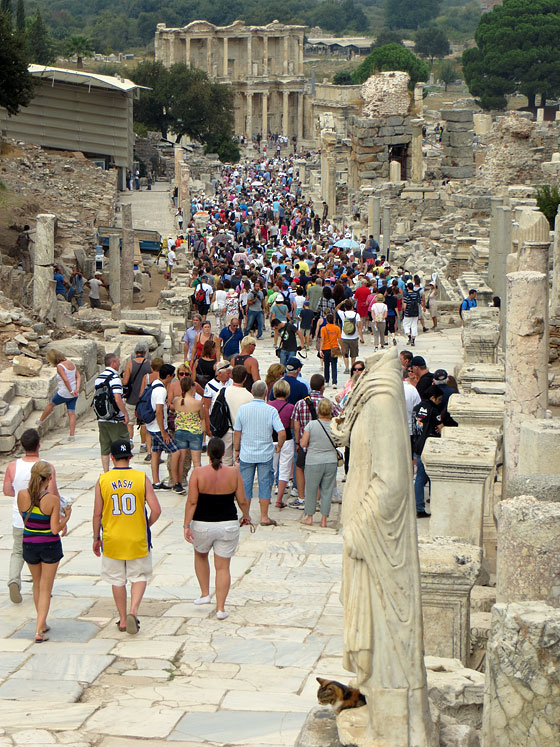
Ephesus: feral cats, marble columns, and crowds. Lots of crowds.
Our tour today actually stopped at four sites…and two “shopping opportunities”. I usually hate these come-ons that are built into many tours around the world. But I enjoyed the two today.
First, we stopped at a leather factory. We watched a short fashion show featuring fancy leather garments. Then we were funneled into a leather showroom. The thing is, I really liked the first leather jacket we saw on the runway: a brown, reversible number that I thought would look good on Kim.
So, I boldly approached a salesman and tried to buy it. I had no luck. Price wasn’t a problem. It was spendy, but I’m sure there was plenty of room to negotiate. Instead, all they had were smalls or sizes like 4XL. The salesman tried to convince me to buy another color or to buy a couple of sizes too big, but I stood firm. No jacket for The Girl.
Our second stop was at a…wait for it…Turkish carpet dealer.
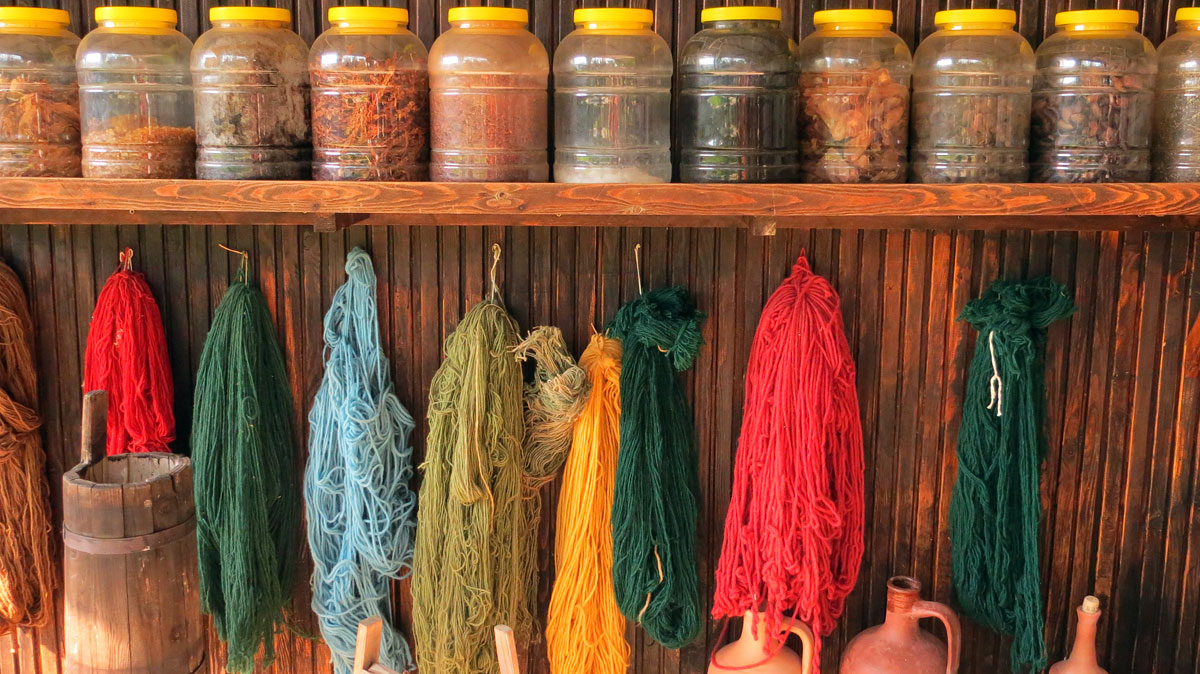
Yarn at the carpet shop.
If you’ve never been to Turkey, this might not mean much to you. But if you have been to Turkey, you’re groaning and shaking your head. I know it. You see, you cannot move five meters in Istanbul without being accosted by a man who wants to invite you for tea in his shop. Or to play backgammon. And oh, by the way, wouldn’t you like to see his carpets? Only to look, not to buy!
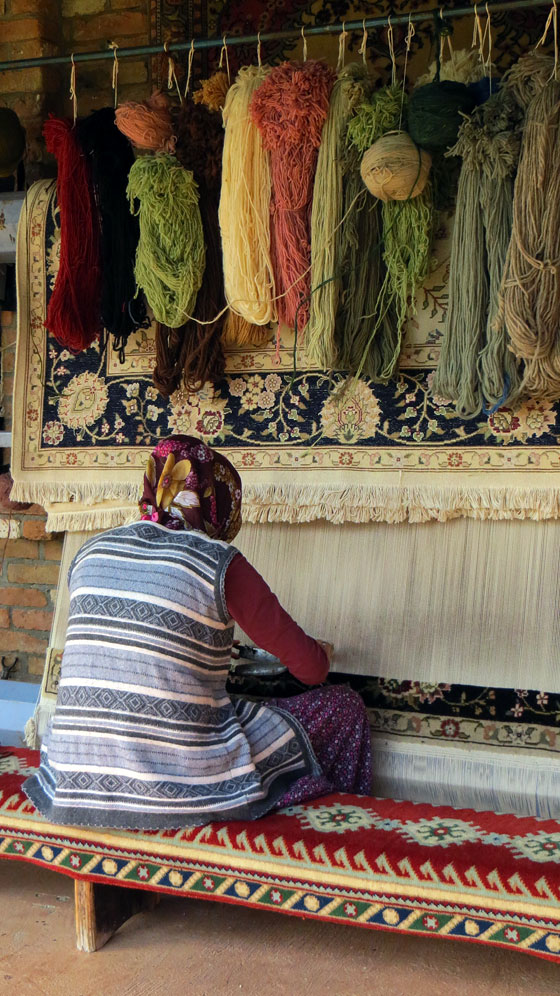
Weavers are paid by the piece and might finish one piece per year.
At this “shopping opportunity”, we received a ten-minute lesson on how silk and wool are harvested, dyed, and woven into the fine carpets on display inside the showroom. Then we were led into said showroom, where the salesman lectured to us about the beauty of Turkish carpets while his assistant unrolled dozens of them on the floor before us.
It was entertaining.
Nick was drawn to the natural carpets, the ones without dyes. These take on the colors of the fibers of the animals from which the wool is harvested. They’re not nearly as soft as, say, a silk rug, but they’ve got an undeniable charm to them. Seizing an opening, the salesman went to work on Nick.
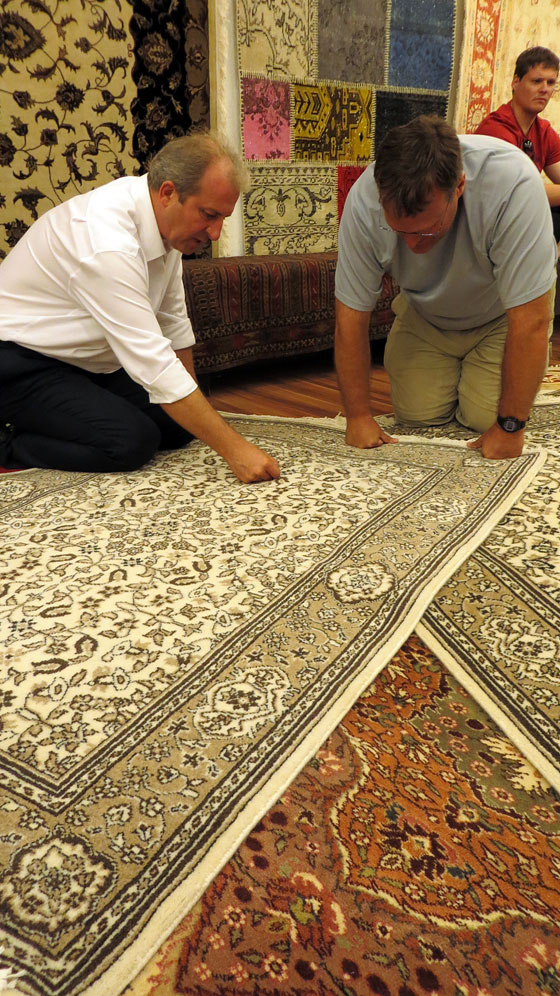
My cousin Nick getting the hard sell from a carpet salesman.
Meanwhile, I was drawn to a tapestry in the corner of the room. Nobody else seemed to notice it, but I thought it was gorgeous. Plus, since it was much smaller than an actual carpet — maybe 12 inches by 24 inches — I thought I might be able to afford it. I asked another salesman about the price. When he asked me to follow him to another room, I knew I was in trouble.
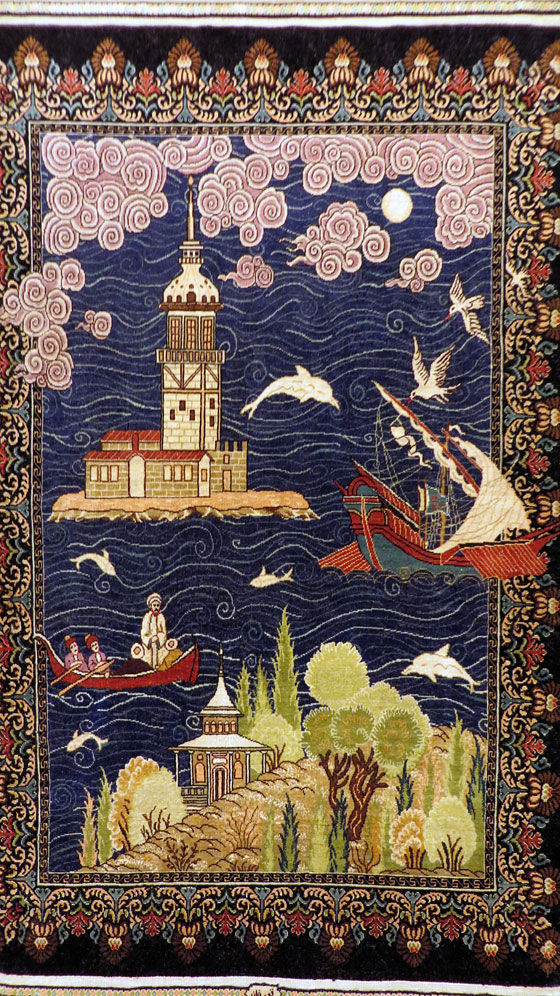
This reminds me of Sinbad. I love it.
“It’s beautiful, no?” the salesman asked me.
“It’s gorgeous,” I said. “How much is it?”
“Look at how fine the craftmanship is,” the salesman said. He flipped the tapestry over so I could see the back. “It has more than 500 knots per square centimeter. It took very long to make. And here it is signed by the artist.”
“Yes, but how much does it cost?” I asked.
“Twenty-eight thousand dollars,” he said. I just about died.
“That’s as much as a car,” I said. “I can’t afford that.”
“Perhaps you could pay in installments,” the man said. “Plus, we can ship to your country for free. You pay now, you have the piece in six to eight weeks.”
“I don’t think so,” I said.
“How about another piece then,” he said. He motioned to his assistant, who brought out four, eight, a dozen more.
“They’re beautiful,” I said. “But they’re all going to be too expensive. How much is that one?”
“That is $38,000, sir.”
“And that one?”
“Only $9,000.”
“Do people really pay these prices?” I asked.
The salesman looked offended. “Yes, of course,” he said. “These are fine pieces of art. Some people appreciate them. See this carpet on the wall? That one costs $150,000. Many people would gladly pay that much for it.”
“Not me,” I said. And I thanked the salesman for his time.
I went back to the main room, where Nick was still talking with the salesman about the carpet he liked. The price seemed reasonable — only $2200 — but ultimately Nick declined. Nobody in our group bought a thing, and the carpet salesmen went hungry.
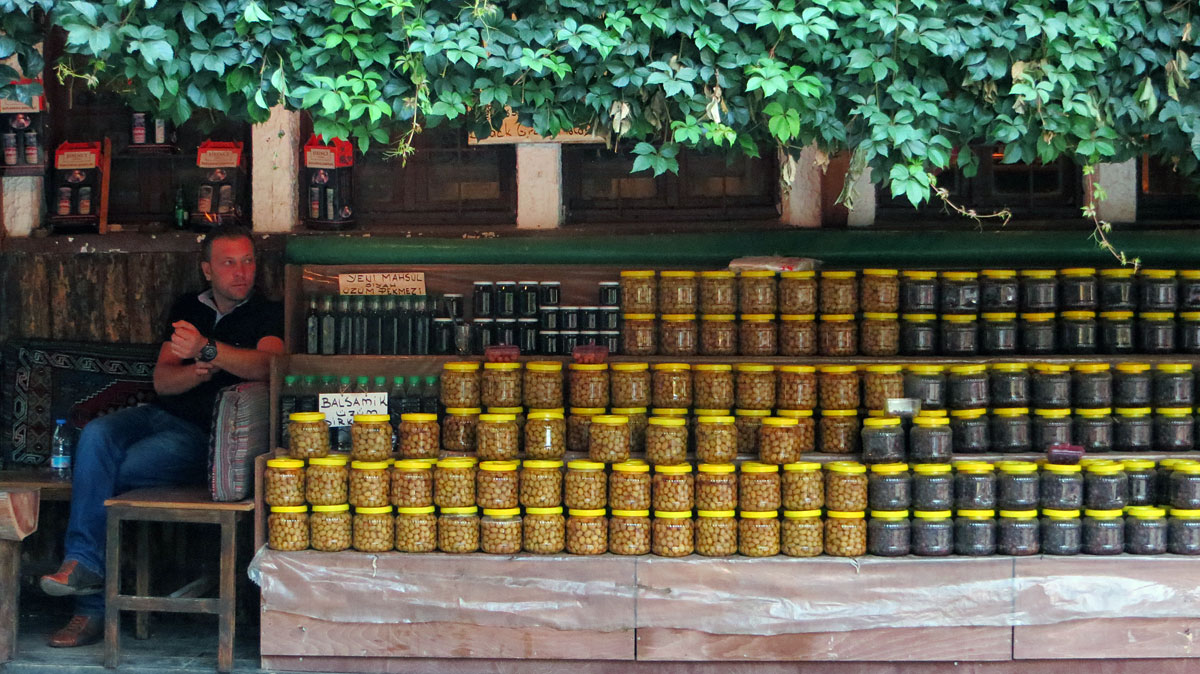
A man selling olives in the hillside town of Şirince.
Back in Selçuk after the tour, Nick and I caught a van (dolmuş) up the hillside to the Greek village of Şirince. There we wandered the streets, looking at the handicrafts for sale (which were slightly different and slightly cheaper than we’ve seen in other parts of Turkey), and petting the cats. Because prices were good, I bought my first souvenirs of the trip.
Before heading home, we stopped for dinner. I ordered the chicken and got to watch while the chef prepared it:
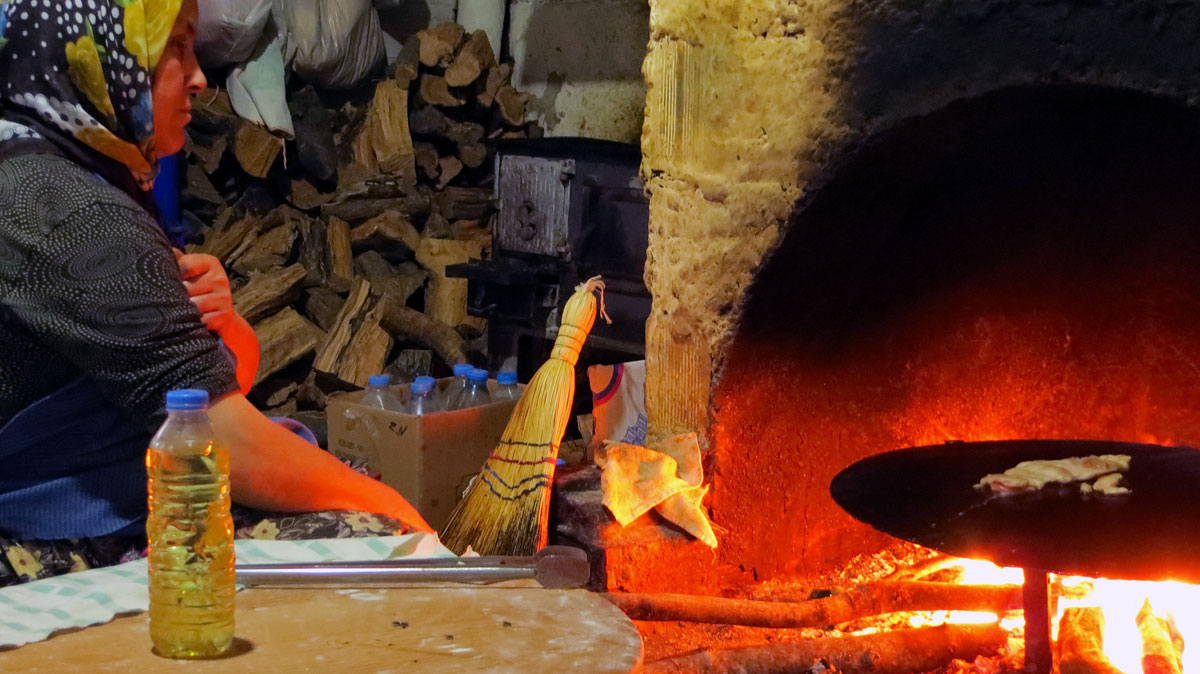
Grilled chicken and a glass of wine for fourteen lira (about seven bucks). Not bad!
How awesome is that?
In the end, it was a good day, even if the primary focus — the ruins of Ephesus — disappointed me. That’s just how travel goes sometimes.
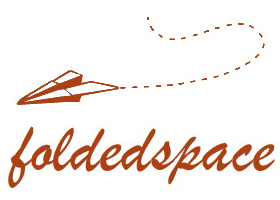
I knew you were in trouble when he took you into the other room! It is beautiful though-and since you have a picture you could just print it and frame it. IT would make for a fun story and a beautiful print.
Wonderful! We are sitting in the sun outside Red Robin and I am reading your story to the girls. Good read!
mmmmm… I want a nice Turkish carpet, but it’ll just get milk spilled all over it…
The tapestry is stunning! I would have choked when he told me the price, though.
When I was at the markets in Istanbul I found that the initial price they throw out at you is hugely inflated. The expectation is not the “cut the price by 20%” type of bargaining we tend to do in the U.S. More like, cut the price by 90-95% on most items.
I did buy a few rugs at the Grand Bazaar. Walking through the bazaar in the morning, every seller tried to get us to go in his shop. Then I bought the rugs, and as I carried the bag with the rugs (it’s a nylon suitcase-shaped bag with handles) through the market in the afternoon, the solicitations stopped. In fact, one or two guys started to invite me into the shop, and then, seeing the rug bag, stopped themselves and said something like “enjoy your new carpet.” If I ever go back to the bazaar, I will ask a seller if I can buy just the bag to carry it around with me!
wowza – yeah, it’s gorgeous, but I wouldn’t be comfortable hanging 28k on my wall (or driving it, for that matter)! I *did* buy a rug in Greece and it was a terrific experience, but it was at a shop some friends directed me to and was a lovely experience. Also it was less than half what Nick was quoted.
I could use some pronunciation keys on all the Turkish you’re slinging around.
It is gorgeous, JD (and I liked your story about almost buying a leather jacket for The Girl!). On an unrelated note: My stepdad brought a few rugs back from Saudi Arabia… we had them all over the house, including one beautiful red hand-knotted number in the kitchen. My mom burned her hand pretty badly one day as she was pulling a pan of lasagna out of the oven and it slipped and she tried to catch it bare-handed, rather than let the contents slop all over the Saudi rug. Some things are better left as art!
I DID groan and shake my head. But not because I’d been to Turkey, but because I’d had the same experience several times in Morocco.
Wow…I rather spend $28,000 on a car AND some more vacations, lol. Glad you are having such a good time!
The pieces (and the pictures!) are beautiful! I have no idea what the carpets are worth, but I suspect the price is much higher for tourists and maybe there was some expectation for haggling? Regardless, it sounds like an interesting experience!
Something like this you hand on a wall very far away from any kind of sunlight. And wow, $28,000 is beyond a lot of money. I’m sure you could have haggled down to say, $20,000 but unless you’re a serious art aficionado with the place to display it, I would have passed too.
Safe travels.
Thanks for sharing your adventures.
I will never travel outside the U.S. unless I am fleeing for my
life. 🙂 I grew up an army brat and, had my fill.
That said, I would have loved a pic of the home Mary was said to
have lived in.
Buy a rug in Kathmandu. You can get a large, hand woven, lots-of-knots-per-square-whatever, for $400.
The place to buy any type of Oriental rug (or anything else for your house) is at an estate auction right here at home. You might have to pay to have it cleaned, but they are so cheap it’s worth it. I see handmade wool rugs going for $50 to $200 all the time.
Ha, yes. The shopping opportunities. I had a tour guide once that called them “shopportunities.” Le sigh.
As someone living in China, I agree with the person who said you cut the price by 90%. Here its more like 70%, unless you go to the Silk or Pearl Market, in which case 90% is true!
Sorry you were ‘crowd crushed’ in Ephesus… There weren’t many people there when we visited, and it makes a huge difference! We’ve bought a number of hand knotted and woven rugs over the years and I would say that in today’s market a new top-of-the-line certified Hereke 100% silk carpet made with best-grade Turkish silk and with 400-to-500 kt/sq/cm knot density would be good value at about 1.25 to 1.33 cents (US) per knot, so that a 12 in x 14 in ‘tapestry’ (rug) with a 500 kt/sq/cm density would be worth about $7,000 (US), or just about 25% of the initial offer of $28,000.